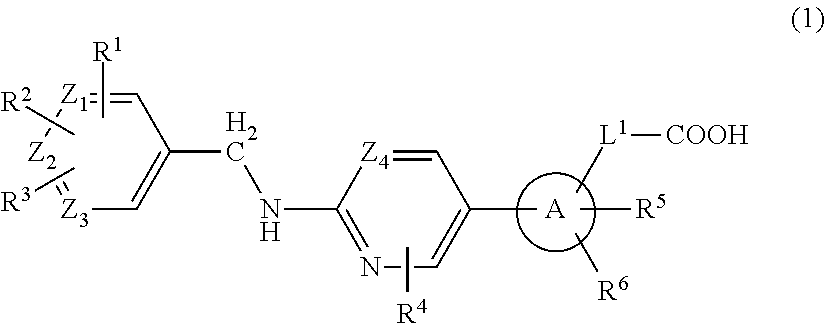2-amino-pyridine and 2-amino-pyrimidine derivatives and medicinal use thereof
a technology of 2-aminopyridine and derivatives, applied in the field of new autotaxin inhibitors, to achieve the effect of superior in autotaxin inhibitory action and effective prophylaxis or treatmen
- Summary
- Abstract
- Description
- Claims
- Application Information
AI Technical Summary
Benefits of technology
Problems solved by technology
Method used
Image
Examples
example 1
2-[6-(3-trifluoromethoxy-benzylamino)-pyridin-3-yl]-3H-benzimidazole-5-carboxylic acid
[0641]
[Step a]
[0642]To a solution of compound 1 (7.50 g, 39.4 mmol) and compound 2 (5.00 g, 32.9 mmol) in N-methylpyrrolidone (50.0 mL) was added trifluoroacetic acid (3.75 mg, 32.9 mmol), and the mixture was ice-cooled. To the reaction solution was added sodium triacetoxyborohydride (8.36 g, 39.4 mmol), and the mixture was stirred for 3 days while raising the temperature to room temperature. To the reaction solution was added water, and the mixture was extracted with ethyl acetate. The organic layer was washed with water and saturated brine, dried over anhydrous sodium sulfate, filtered, and concentrated under reduced pressure. The residue was purified by silica gel chromatography. The obtained solid was suspended and washed in hexane to give compound 3 (4.20 g, 39.2%).
[0643]MS(ESI)m / z: 327(M+1)+.
[Step b]
[0644]To a mixed solution of compound 3 (3.50 g, 10.7 mmol) in tetrahydrofuran (18.0 mL) and m...
example 2
2-[6-(3-trifluoromethoxy-benzylamino)-pyridin-3-yl]-3H-benzimidazole-4-carboxylic acid
[0650]
[Step a]
[0651]A mixed solution of compound 1 (200 mg, 0.64 mmol) which was obtained in Example 1, Step b, compound 2 (106 mg, 0.641 mmol), diisopropylethylamine (167 μL, 961 μmol) and 50% solution (377 μL, 0.641 mmol) of propanephosphonic acid anhydride (T3P) in ethyl acetate was heated under microwave radiation at 160° C., and the mixture was stirred for 30 min. To the reaction solution was added saturated aqueous sodium hydrogen carbonate solution (20.0 mL), and the mixture was extracted with chloroform. The organic layer was dried over anhydrous sodium sulfate, filtered, and concentrated under reduced pressure. The residue was purified by silica gel chromatography to give compound 3 (83 mg, 29.3%).
[0652]MS(ESI)m / z: 443(M+1)+.
[Step b]
[0653]To a mixed solution of compound 3 (80.0 mg, 180 μmol) in tetrahydrofuran (1.60 mL) and methanol (800 μL) was added 4 M-aqueous sodium hydroxide solution ...
example 3
2-[6-(3-trifluoromethoxy-benzylamino)-pyridin-3-yl]-benzoxazole-6-carboxylic acid
[0655]
[Step a]
[0656]To a solution of compound 1 (150 mg, 0.480 mmol) which was obtained in Example 1, Step b, and compound 2 (73.0 mg, 0.4326 mmol) in N-methylformamide (3.00 mL) were added 1-ethyl-3-(3-dimethylaminopropyl)carbodiimide hydrochloride (WSC.HCl) (109 mg, 0.556 mmol) and 1-hydroxybenzotriazole (HOBt) (65.0 mg, 0.480 mmol), and the mixture was stirred at room temperature for 20 hr. Diisopropylethylamine (228 μL, 1.31 mmol) was added and the mixture was further stirred for 20 hr. To the reaction solution was added water, and the mixture was extracted with ethyl acetate. To the aqueous layer was added 1N-hydrochloric acid to adjust to pH6, and the mixture was extracted with ethyl acetate. The organic layers were combined, dried over anhydrous sodium sulfate, filtered, and concentrated under reduced pressure. The residue was purified by silica gel chromatography to give compound 3 (99.0 mg, 49....
PUM
| Property | Measurement | Unit |
|---|---|---|
| temperature | aaaaa | aaaaa |
| temperature | aaaaa | aaaaa |
| temperature | aaaaa | aaaaa |
Abstract
Description
Claims
Application Information
 Login to View More
Login to View More - R&D
- Intellectual Property
- Life Sciences
- Materials
- Tech Scout
- Unparalleled Data Quality
- Higher Quality Content
- 60% Fewer Hallucinations
Browse by: Latest US Patents, China's latest patents, Technical Efficacy Thesaurus, Application Domain, Technology Topic, Popular Technical Reports.
© 2025 PatSnap. All rights reserved.Legal|Privacy policy|Modern Slavery Act Transparency Statement|Sitemap|About US| Contact US: help@patsnap.com



